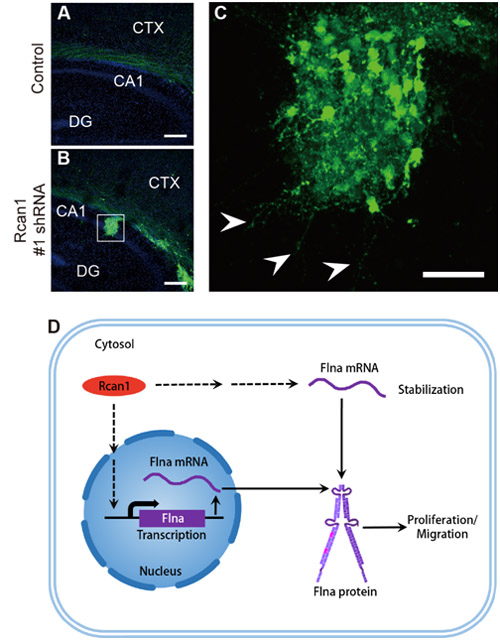Time:2015-01-19
Periventricular heterotopia (PH) is a cortical malformation characterized by aggregation of neurons lining the lateral ventricles. Patients with PH usually suffer intractable epilepsy. The most common familial form of PH is caused by mutations in FilaminA (FLNA), which encodes an F-actin cross-linking protein essential for cytoskeleton rearrangement and cell migration. However, the molecular mechanism underlying the pathogenesis of PH is still unclear.
In a recent study, graduate student LI Yang and colleagues under the supervision of Dr. XIONG Zhi-Qi at the Institute of Neuroscience (ION), Shanghai Institutes for Biological Sciences, Chinese Academy of Sciences, reported that Regulators of calcineurin 1 (Rcan1), a Down Syndrome-related gene, plays an important role in radial migration of rat cortical neurons. Down-regulation of Rcan1 expression using shRNA impaired neural proliferation and migration, and led to the formation of periventricular heterotopia. They further demonstrated that Rcan1 knockdown significantly decreased the expression of FLNA mRNA. Finally, overexpression of FLNA in Rcan1 knockdown neurons prevented migration abnormalities.
These findings demonstrated that Rcan1 acts upstream of FLNA in regulating radial migration and suggested that impairment of Rcan1-FLNA pathway may underlie PH pathogenesis.
This work entitled “Rcan1 Deficiency Impairs Neuronal Migration and Causes Periventricular Heterotopia” was published in The Journal of Neuroscience on Jan 14, 2015. The study was supported by grants from the Ministry of Science and Technology (973 Program) and the National Natural Science Foundation of China.

Figure legend: Knockdown of Rcan1 leads to the formation of periventricular heterotopia.
Figure A and B, Representative coronal sections showing periventricular heterotopia in Rcan1 knockdown brains;
Figure C, Zoomed image of the boxed area in (B) showing that cells in the nodule exhibited neurite-like structure (arrowheads);
Figure D, Rcan1 acts upstream of Flna in regulating radial migration.
 附件下载:
附件下载: